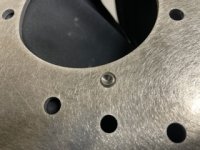Offline
I made this a separate post because the question is so specific. I noticed that the backside of the tensioner pin that I received from Moss is concave. See pic. I seem to recall someone once saying that you’re supposed to “peen“ the backside of that pin to guard against it coming out. Naturally, my questions are whether that is correct and, secondly, how would I pin that pin effectively. Thanks for the help.

 Hi Guest!
Hi Guest!

 smilie in place of the real @
smilie in place of the real @
 Pretty Please - add it to our Events forum(s) and add to the calendar! >>
Pretty Please - add it to our Events forum(s) and add to the calendar! >> 

